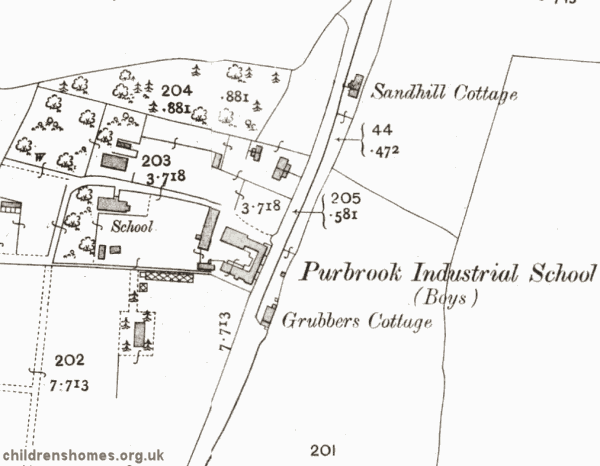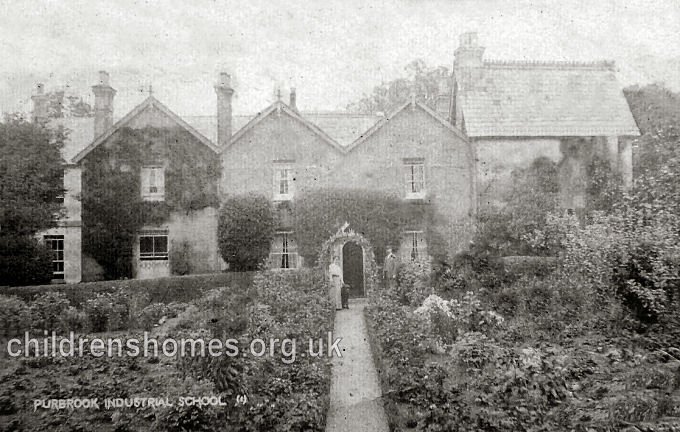Purbrook Industrial School for Boys, Purbrook, Hampshire
The Purbrook Industrial School for Boys, on Stakes Hill Road, to the east of Purbrook, was opened in 1868. It was established, in the face of some local opposition, through the efforts of Mr John Deverell, of Purbrook Park, who had also provided the School's premises and 18 acres of land. The establishment was officially certified to begin operation on November 21st, 1868. The first superintendent and matron were Mrs and Mrs Jerram.
By May, 1871, 38 boys were in residence. In addition to classroom lessons, the boys received industrial training. This included work on the farm and in the garden, with a few of the boys employed in shoemaking and mat-making.
In 1875, Mr and Mrs Horth took over as superintendent and matron. Additions to the premises at this date included a lavatory, office, and dormitory.
By July, 1877, there were 67 inmates in residence and an inspection report complained that the accommodation was inadequate for this number, especially in the dormitories. The School's facilities now included a mast and rigging to provide nautical instruction for boys inclined to the sea. During this year, a charge of cruel treatment of the boys was raised against the labour-master, Michael Cahill. Upon investigation, the charge was not fully substantiated, but it came out in evidence that irregular and unauthorised punishments occasionally took place, without due record or report.
In 1878, the Horths were succeeded by Mr and Mrs A.J. Fielder. Building works were begun to improve the accommodation including an enlargement of the dormitories, construction of a new sick-room and a room for the labour-master.
A report in 1896 situation noted that the School's location was open, pleasant, and healthy. However, the dining-hall and lavatory were unfortunately below the level of the road. The land was laid out as garden, meadow and wood. The water came from a public supply with good pressure, and each dormitory contained appliances for extinguishing fire. The schoolroom was now some little distance from the main building, the former one now being utilised as a recreation room. The washhouse and bakery were also detached. The allocation of boys to the various work tasks was as follows: tailors, 7; shoemakers (institutional work only), 6; bakehouse, 2; kitchen and house, 6; in school full time, 10. The reminder were employed about the 11 acres of garden (flowers and vegetables). The farm stock consisted of a horse, a number of pigs, and some poultry. There was a brass band of 18 performers, from which 4 boys had recently gone on to Royal Navy bands. Places were found for the boys leaving on licence and discharge, frequently in gentlemen's houses or gardens, and the superintendent occasionally visited them. Besides the ordinary playground, there was a good playing field which was used every evening in summer for cricket. There was a good open-air swimming bath, and instruction in swimming was given, and also in gymnastics in a gymnasium, built and fitted for the purpose. There was an annual day-trip to Hayling Island, and several picnics in the summer, especially during three weeks' holiday. There was a good recreation room, the school library contained 102 books, and concerts and other entertainments were got up during the winter. Musical drill with clubs and imitation rifles was carried on, except in the very hot months.
In 1900, building extensions included a new dining-hall with dormitory above, and range containing a bakehouse, shoe and tailoring shops and laundry. On October 9th, 1900, the official capacity of the School was increased to 95.
The School site is shown on the 1907 map below.

Purbrook Industrial School for Boys, 1907.

Purbrook Industrial School for Boys, early 1900s.
On March 25th, 1903, Mr and Mrs T.W. Kitching, formerly schoolmaster and schoolmistress at the School, took over as superintendent and matron. Mr Williams will still in post in 1920.
In 1912, the School was taken over by Hampshire County Council.
In 1933, the institution became an Approved School, one of the new institutions introduced by the 1933 Children and Young Persons Act to replace the existing system of Reformatories and Industrial Schools. The School could then accommodate up to 77 Junior Boys, aged under 13 at their date of admission. The headmaster in 1935 was Mr W.D. Williams.
In 1939, the School was evacuated to Caerdeon Hall, Bontddu, Merionethshire. In 1948, it reopened in new premises at Winton House, Winchester.
The Cosham buildings no longer survive and modern housing now occupies the site.
Records
Note: many repositories impose a closure period of up to 100 years for records identifying individuals. Before travelling a long distance, always check that the records you want to consult will be available.
- Hampshire Record Office, Sussex Street, Winchester SO23 8TH. Holdings: Admission registers (1884-1904); Managers' minute book (1869-1901, 1933-41); Annual reports (1900-12); Photographs (1915-48); School files (1943-1945).
Census
Bibliography
- Higginbotham, Peter Children's Homes: A History of Institutional Care for Britain's Young (2017, Pen & Sword)
- Mahood, Linda Policing Gender, Class and Family: Britain, 1850-1940 (1995, Univeristy of Alberta Press)
- Prahms, Wendy Newcastle Ragged and Industrial School (2006, The History Press)
Links
- None noted at present.
- The Therapeutic Care Journal — has a number of articles relating to Approved Schools.
Except where indicated, this page () © Peter Higginbotham. Contents may not be reproduced without permission.


